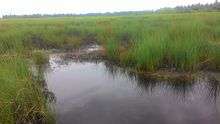Hulhumeedhoo
| Hulhumeedhoo | |
|---|---|
| Island | |
|
Hulhumeedhoo Aerial view with Hulhudhoo on the left (south) and Meedhoo on the right (north). | |
 Hulhumeedhoo Location in Maldives | |
| Coordinates: 0°35′14″S 73°13′56″E / 0.587243°S 73.232281°ECoordinates: 0°35′14″S 73°13′56″E / 0.587243°S 73.232281°E | |
| Country | Maldives |
| Geographic atoll | Addu Atoll |
| Administrative atoll | Seenu Atoll |
| Distance to Malé | 530 km (330 mi) |
| Area | |
| • Total | 3.24 km2 (1.25 sq mi) |
| Population (2013) | |
| • Total | 6,492 |
| • Density | 2,000/km2 (5,200/sq mi) |
| Time zone | MST (UTC+05:00) |
Hulhumeedhoo (Dhivehi: ހުޅުމީދޫ) or Hulhudhoo-Meedhoo[1] is one of the inhabited islands of the Addu Atoll (also known as Seenu Atoll) in Maldives. Hulhumeedhoo is one of the largest islands in the Maldives. Hulhumeedhoo is the only inhabited island in Eastern side of Addu Atoll. Although the island is geographically a single island, it is administratively divided into two. That is Hulhudhoo and Meedhoo. The exact reason for the separation of people is unknown. This is the only island in Maldives which is geographically one, but politically and administratively two islands. When Addu Atoll declared status of a city, the two administrative offices was brought under one council office where the Councillor is elected from the votes of the residents of Hulhumeedhoo.
History
The original settlers were Divehi people of Aryan origin. An Arab traveller by the name of Yoosuf Naib planted the seed of Islam and built a place to worship Allah in the 12th century; this became the country's first mosque. The island has since been known as a centre of learning and Islamic religious education, famous for the scholars it has produced. Since the 16th century, eight natives of Meedhoo have served as fandiyaaru, or qazi, at Malé. To this day, Meedhoo's Ulamma and other ecclesiastics hold their own with those of the capital.[2]
Meedhoo is one of the largest islands in the Maldives. Despite its distance from the capital Malé and its comparatively small population, Meedhoo has maintained a disproportionate importance in Maldivian affairs.
The oldest cemetery in the Maldives, Kōgaṇṇu, is located in Meedhoo.
Meedhoo and Hulhudhoo
There is some rivalry between the people of Meedhoo and Hulhudhoo. Hulhumeedhoo is actually one Island but the government divided it into two Islands. Before making two administrative divisions, the people also separated into two communities who now live in Meedhoo and Hulhudhoo. The reason of separation is unknown but the current locals also have separated and there is now competition and rivalry between the people of the two Islands. There is even a canal (Aaru) which was used to separate the two Islands. The north of the canal is Meedhoo and south is Hulhudhoo. The canal joins the Island's western waters to a large freshwater pond in Hulhumeedhoo Kilhi. The canal exists today underground but the entrance which are made from concrete is visible and runs from the sea through the backyards of some homes into underground pipes in the streets and finally into a large pond in the Marshy area known as Hulhumeedhoo Kilhi.
Landmarks
There are many landmarks located in the island of Meedhoo. Including the ancient cemetery in the Maldives, Kogannu.
Other landmarks include newly finished Eedhigamooli Beach, the Kogannu Beach, the Hulhumeedhoo Kalhibih Beach and the Hulhumeedhoo Kilhi.
Hulhumeedhoo Kilhi
Hulhumeedhoo Kilhi and its freshwater ponds. Hulhumeedhoo Kilhi is a large marshy area which covers most of the land area of Hulhumeedhoo (it covers most of Meedhoo and Hulhudhoo). "Kilhi" usually means either Lake or Mangrove in Dhivehi language of Maldives. But here it refers to the large marshy area where hundreds (or thousands) of freshwater ponds (most of them circular shaped and measures around 7-15 feet in average) are located. The ponds are known to have a few freshwater fish species found all year round.[3] The freshwater fish species found include, Greenstripe Barb (known by the locals as 'Fenfila'), Whipfin silverbiddy (known by the locals as 'Foo-tu-mas', which literally means '1 foot fish' even though they usually do not grow to that length) and a species of Freshwater Eel.[4]
The Hulhumeedhoo Kilhi is a common location where Marsh Wildfires happen 3-4 times every year. The fires could be intentionally started by the locals or could be started naturally.


References
- ↑ Hulhudhoo-Meedhoo - Inhabited Island - Seenu Atoll isles.egov.mv
- ↑ "Koagannu cemetery, Meedhoo island, Addu Atoll". ExploGuide. Retrieved 2017-06-21.
- ↑ "Mathikilhi | Meedhoo.com". www.meedhoo.com. Retrieved 2017-06-21.
- ↑ "Freshwater fish of Maldives". fish.mongabay.com. Retrieved 2017-06-21.
